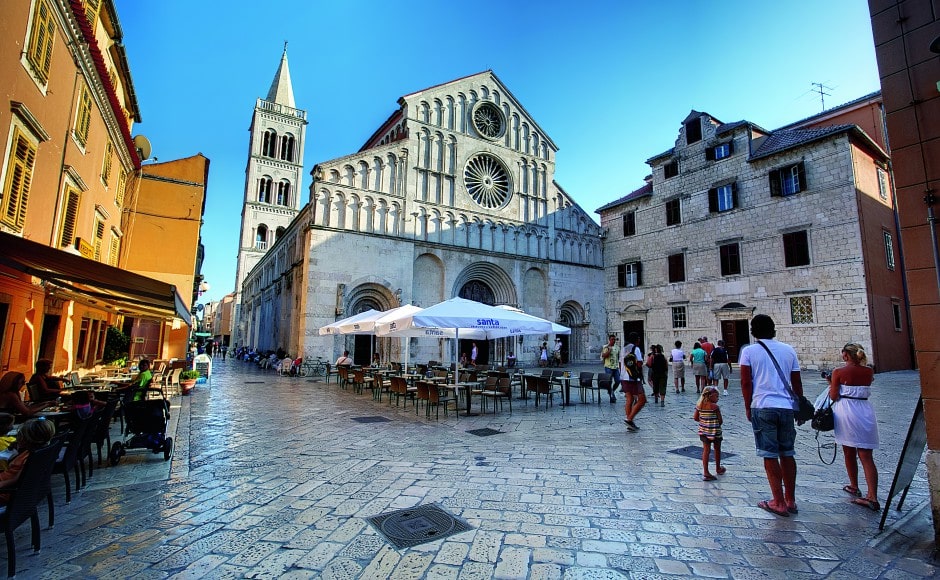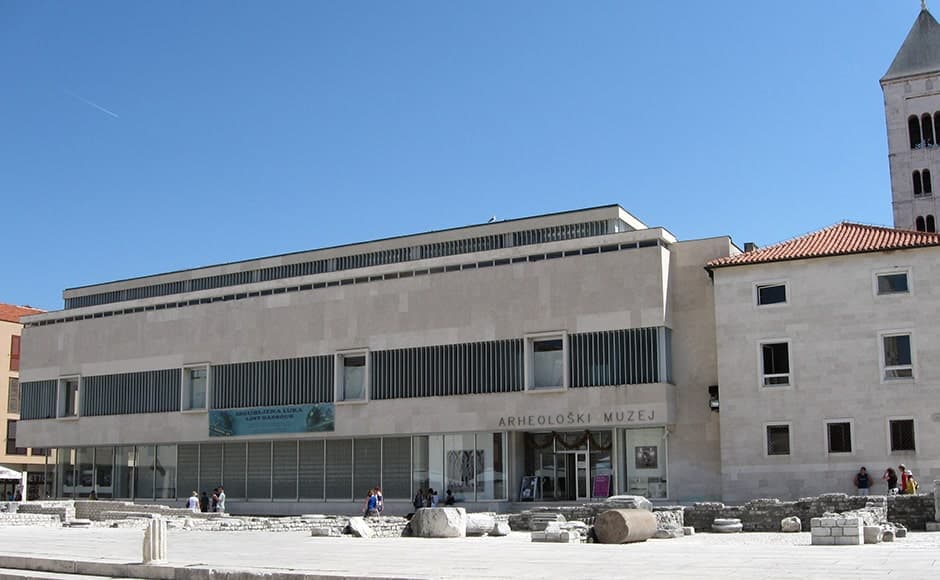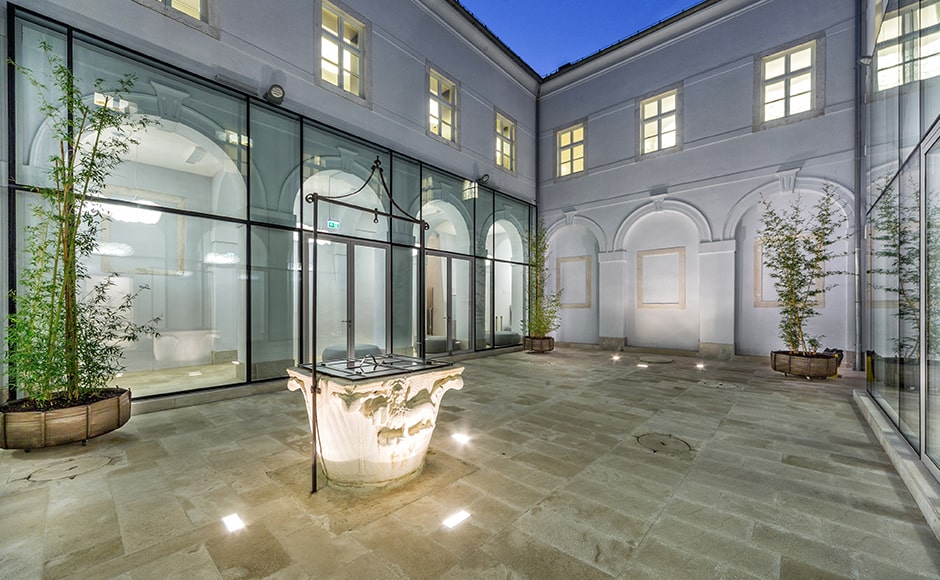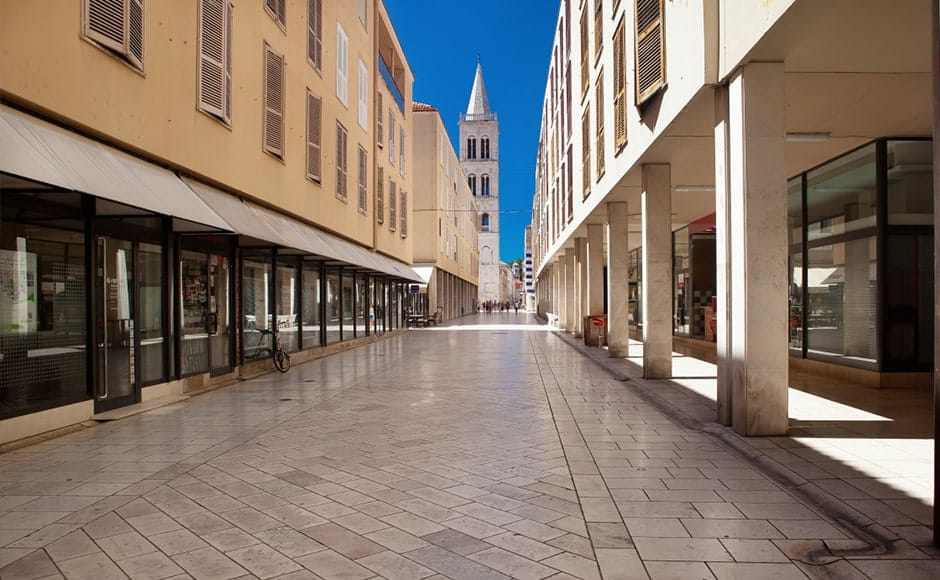
Zadarska katedrala sv. Stošije (Anastazije) najveća je katedrala u Dalmaciji. U najstarijim dijelovima je starokršćanska bazilika, a današnji izgled romaničke crkve oblikovan je u 12. stoljeću. Za vrijeme križarske opsade i zauzimanja grada 1202. godine katedrala je bila oštećena, a kasnije obnovljena i produžena. Portali su bogato ukrašeni reljefima. Glavni portal ima u luneti reljef gotičkog stila i posvetni natpis nadbiskupa Ivana iz 1324. godine. Njezin zvonik građen je u 15. i 19. stoljeću, i to uglavnom u stilu neoromanike.

Morske orgulje su umjetnički glazbeni objekt i eksperimentalni glazbeni instrument koji divne zvukove i melodije stvara snagom ljuljanja morskih valova. Instalacija izgleda kao niz širokih stuba koje vode u more, a koje pod sobom kriju dovitljivu konstrukciju. Poznati arhitekt Nikola Bašić osmislio je genijalni sustav rezonantnih komora koje proizvode sinkopirane, uvijek nove melodije, koje istovremeno smiruju i uzbuđuju bezbrojne začuđene i zadivljene posjetitelje te ih privlače da se opuste i ostanu na Rivi satima, samo da čuju bar još jedan sanjarski ton prije nego što odu.
Pozdrav Suncu je još jedna instalacija ovog briljantnog arhitekta koja simbolizira ljudsku komunikaciju s prirodom. Ovaj uzbudljivi spomenik sastoji se od 300 višeslojnih staklenih solarnih ploča, koje tijekom dana apsorbiraju sunčevu energiju, a nakon zalaska sunca stvaraju spektakularnu svjetlosnu predstavu uz more. Ove su instalacije praznik za sva vaša osjetila.

Sa staklenog lica Arheološkog muzeja u Zadru zrcale se rimski Forum i sveti Donat, uz kojega je muzej neraskidivo vezan. Od 1880. godine u svetom Donatu su se izvodili zaštitni i restauratorski radovi, s nakanom da se u njega smjesti Arheološki muzej.
Arheološki muzej je najstariji zadarski muzej i drugi najstariji u Hrvatskoj. Osnovan je 1832. godine kao opći Narodni muzej, a danas čuva više od 100.000 arheoloških predmeta iz svih kulturnih i povijesnih razdoblja od paleolitika do kraja 11. stoljeća. Muzej ima i svoje glasilo, a već gotovo 60 godina u sklopu preparatorske radionice bavi se i ručnom izradom suvenira – amfora, posuda, fibula, nakita i drugog vrijednog muzejskog materijala.

Sirnbol grada Zadra i najpoznatija monumentalna građevina u Hrvatskoj iz ranoga srednjeg vijeka (9. st.). Okrugla predromanička crkva koja se do 15. stoljeća nazivala crkva sv. Trojstva, a od tada nosi ime Sv. Donat, po biskupu koji ju je dao sagraditi. Prvi put crkva se spominje sredinom 10. stoljeća u spisima bizantskog cara Konstantina Porfirogeneta. Danas se njezin prostor zbog izvanrednih akustičnih karakteristika koristi za glazbene programe (Glazbene večeri u Sv. Donatu).

Kneževa palača spomenik je kulture čiji povijesni izvori sežu u 13. stoljeće. Obnovljena sredstvima iz EU fondova 2017. godine, Kneževa palača suvremeno je opremljen kulturno povijesni kompleks i turistička atrakcija.
Palača se prostire na 2000 četvornih metara i na jednom mjestu objedinjuje muzejski prostor, atrij, koncertnu dvoranu, dvorane za privremene izložbe, video galeriju, multimedijalnu dvoranu te prostore za edukaciju i kreativno izražavanje. Arhitektura palače, ambijentalnost prostora i slikovitost okruženja dodatna je zanimljivost za ljubitelje kulture. Kao polivalentni kulturni centar svojim programom nastoji obuhvatiti interese različitih posjetitelja.

Trobrodna bazilika s tri bogato ukrašene polukružne apside, romaničkog stila, ime je dobila po sv. Krševanu mučeniku, zaštitniku grada Zadra. Unutrašnjost crkve krase freske romaničko-bizantskih karakteristika.

Foša je komunalna lučica u Zadru i jedan od gradskih simbola, a zbog njezine stoljetne ambijentalnosti i naslonjenosti na renesansne bedeme, omiljeno je mjesto za šetnju, fotografiranje i uživanje u raskošnom lučkom koloritu.
Bedemi nad ambijentalnom i povijesnom lučicom Foša u Zadru podignuti su u 16. stoljeću, a dio njezine mistične i drevne atmosfere postoji i danas. Od povijesnih Kopnenih vrata na koja su naslonjena, pa sve do zgrade Sveučilišta u Zadru, lučica Foša neizostavna je šetnica za putnike i turiste te jedan od prepoznatljivih gradskih simbola.
Zadar je jedan od onih europskih povijesnih gradova čiji je identitet vezan uz UNESCO svjetsku baštinu. Njegove gradske zidine bile su neosvojive i stoljećima su ga branile od osvajača te pružale sigurno utočište njegovim stanovnicima, a danas su omiljeno šetalište putnicima iz cijelog svijeta.

Najstarija je dalmatinska crkva sagrađena u gotičkom stilu (1283.). Predstavlja tip tzv. gotičke redovničke crkve koju karakterizira jednobrodni prostor s malo podignutim svetištem. U 18. stoljeću crkvi je izmijenjen izgled. Iza glavnog oltara crkve iz 1672. godine nalazi se nekadašnje svetište i u njemu korska sjedala bogato ukrašena rezbarijama u stilu cvjetne gotike iz 1394. godine, rad Giacoma da Borga Sansepolcra. Sakristija, koja se nastavlja na kor, važna je za hrvatsku povijest jer je u njoj sklopljen Zadarski mir izmedu Mletačke Republike i ugarsko-hrvatskog kralja Ludovika Anžuvinca, kojim su se Mlečani odrekli svojih pretenzija na Dalmaciju. U uređenoj riznici do sakristije nalazi se umjetnička zbirka crkve s velikim brojem eksponata od kojih je najvrednije slikano raspelo iz 12. stoljeća, Južno od crkve je renesansni klaustar sagrađen 1556. godine s bogatom bibliotekom.

Narodni trg u Zadru formiran je u srednjem vijeku kao Platea magna (veliki trg), središte je svjetovnog života Zadra i centar gradske uprave s današnjom Gradskom ložom (13. stoljeće – 1565.), Gradskom stražom (1562.) i novovjekom Gradskom vijećnicom (1934.). Naziv Platea Magna zamijenio je kasniji naziv Gospodski trg (Piazza dei Signori), a nakon II. svjetskog rata ustalio se današnji naziv Narodni trg.

Nalazi se ispred crkve su. Donata i Nadbiskupske palače. Gradski trg iz rimskog vremena, građen od 1. stoljeća pr. Kr. do 3. stoljeća po. Kr, veličine 45 x 90 m. Forum je inače naziv glavnoga trga svih gradova starog Rima na kojem se odvijao kompletan javni život grada. Prvobitno se na njegovu jugozapadnom dijelu nalazio oko dva metra povišeni kapitolij, usred kojeg se dizao hram posvećen Jupiteru. Junoni i Minervi, a na njegovoj sjeverozapadnoj strani sačuvan je jedan monumentalni stupac. koji je u srednjem vijeku služio kao “stup sramote”.
Savjet: Pokušajte planirati svoj posjet po noći kad ruševine budu osvijetljene.

Od najstarijih vremena u Zadru kao Via Magna, Strada Grande ili Ruga Magistra, zadarska je Kalelarga glavna gradska ulica. Zadranima je još i više; gradska žila kucavica, kultni prostor i simbol grada uz kojega su vezane najljepše uspomene.
U Zadru se službeno naziva Široka ulica (Calle Larga, Kalelarga), a opjevana je kao niti jedna druga ulica ili gradski simbol. Ima svoju himnu, mjesto je svakog ozbiljnog gradskog trača ili novosti. Na Kalelargi i susjednom Narodnom trgu dočekuju se i slave veliki sportski uspjesi zadarskih klubova, kao što se s prvom jutarnjom kavom nježno oplakuju porazi i nekadašnje ljubavi.

Muzej antičkog stakla suvremena je i jedinstvena kulturna institucija u cijelom svijetu, a posjeduje specijaliziranu arheološku zbirku s više od 5.000 staklenih predmeta iz razdoblja antike od prvog stoljeća prije Krista do 5. stoljeća. Ima stalni postav i atraktivnu staklarsku radionicu u kojoj se metodom ručnog puhanja izrađuju replike antičkog stakla.